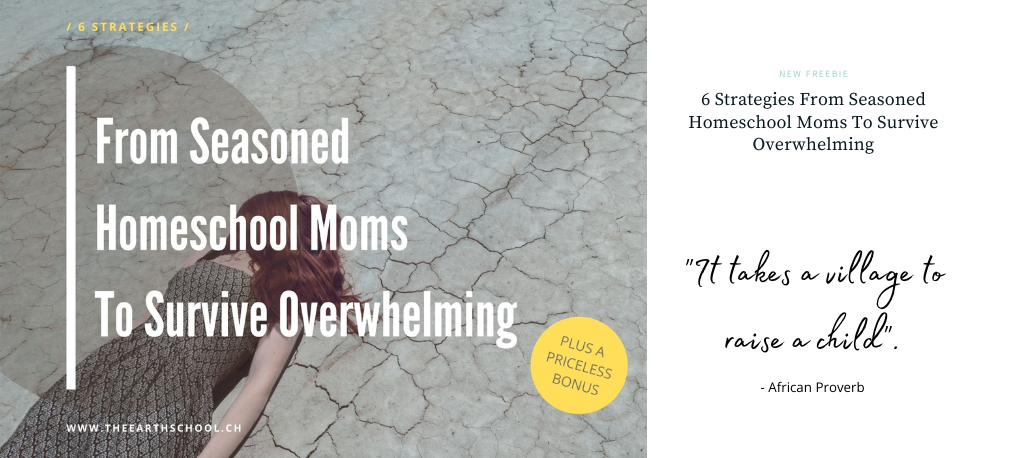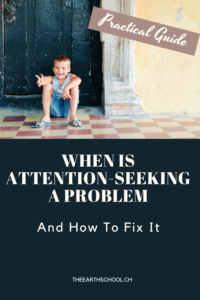
#39 Learn These 4 Astonishing Rules For An Easy And Successful Homeschooling
Would you rather listen to this post? It’s here
How much information, rules, boundaries, values, knowledge, comments, questions, orders, demands, judgments, do you think your children hear in a day?
And what portion of it do you think they remember? You can measure that by the number of time you repeat something 🙂 But is it truly our children’s fault that they can’t remember all of it? Are you giving so much information to your children that they’re getting lost?
Dealing with too much information already? Download the PDF and reflect carefully about what you’re learning!
Little Humans Need Information To Survive
Children need us to teach them how to survive, and as humans, we also want them to thrive. What better way to achieve this goal than by giving them the information they need?
Many mammals teach survival skills to their children. Some, even teach them to live in social groups! Think gorillas, wolves, or elephants.
But humans live in a complex reality where social codes are ever-evolving. As parents, we fear for our children. We wonder how they will do in a world we barely understand ourselves, with governments guided by lobbies, media we’re not sure we should trust, and an unstoppable flux of information.
Too much information kills the information. – Bernard Werber
Governments and churches used to censor information but they don’t need to anymore because there is little chance that a piece of information gets noticed in the ocean of daily news and fake news.
Tell me, do you sometimes feel overwhelmed by all the information surrounding you? For example, when all the pandemic subjects arose last year, did you wonder who to believe or not? Why the media would contradict themselves? What emotions did you feel?
Our world is complex, and as an adult, we sometimes don’t know where to put our trust, I mean, I often doubt even myself! Because our minds are flooded with information and we can’t sort it out.
And unconsciously, we repeat this pattern with our children.
Is The Information You Share Accurate And Useful?
Let me repeat the question I asked you at the beginning of this post: how many rules, boundaries, values, knowledge, comments, questions, orders, demands, judgments, your children hear in a day?
We drown them in information and we expect them to remember it all. And just as the world does to us, we sometimes give them contradictory information AND still expect them to guess what’s the right thing to do.
I know that you don’t do it on purpose, I don’t. I know that you have your child’s best interest at heart and that you want them to be as prepared as possible for their life, that you want to give them as much as possible in the short time you have to raise them.
Today I invite you to make a beautiful shift in your education, and I offer you the means to do it.
What if you could give your children only the information they need, what if you could share with them the core of what you want to teach them, without all the noise around it?
A Child’s Brain And How They Learn
A newborn baby has all of the brain cells (neurons) they’ll have for the rest of their life, but it’s the connections between these cells that really make the brain work.- First things first
Research allows us to understand how a child’s brain develops. Basically, synapses create connections between neurons. It is an active process, not a passive one. The children get information and organize it, creating connections in the process. Growing up, the brain creates more and more connections, allowing them to process more complex information. And all this process is influenced by emotions.
A typical healthy human brain contains about 200 billion nerve cells, or neurons, linked to one another via hundreds of trillions of tiny contacts called synapses. – Science Daily
Your growing child’s brain has a lot to do between hearing the information, processing it, and creating new connections to keep it and re-use it. All this while dealing with their emotions.
Maybe we can make it a little easier for them by not drowning them in information. Think about it, if they have to work on thousands of pieces of information in a day, how could they do it? Compared to having the time to work on a few hundreds and make sense of them?
Our world is much more interested in quantity than quality. This is capitalism speaking. But do we want our children’s minds to be a cheaply made product or a lovingly crafted piece of art?
Give Less Information To Prevent Saturation
What happens when you get too many stimuli? You shut the world out.
Let’s get back to the example of the pandemic information flood when it all started. After reading countless articles and watching YouTube videos, listening to podcasts, and screening the news, your emotional level became too intense and you shut off. You couldn’t take in any more information.
Another example of that: Have you ever noticed how a young baby, when the room is too noisy, too full of people, just goes to sleep? They are protecting themselves from too much information and emotions. They cannot process it all, so they turn off their brain.
Children have so much to learn from their birth to their first independent steps in the world, and we would like to make sure they have everything they need. But how can we know what they’ll need?
Children don’t need thousands of informations to thrive, because as they grow up, they develop the ability to transfer their knowledge to new situations.- Berenice Goin
First of all, we don’t know what tomorrow’s world will be made of. Many jobs won’t exist anymore while some we can’t even imagine will be created. The way we do things will be different.
It is not our role to decide what our children will become. Will they want to travel or run a farm? Become an engineer or a singer? Stay in their hometown or move to another country? How can you prepare them for EVERY possibility?
The best way to do so is to give children skills and not knowledge. If they know how to learn, where to find information, and help, then they can do anything.

The Challenges Of Giving The Right Education
Let’s be honest. We give way too much information to our children. I remember the days where we started to home-school our children. My eldest was only 5 and I already feared he would be behind, that he would miss primordial knowledge, could never adapt to society, and he would inevitably hate me.
I spent my days trying to teach him to read and write, do some math and science. But then I realized I was only doing academic work. Let’s also teach him crafts and music, everyone should be able to read music and knit. Then I realized he would also need good values and I would spend time teaching him about ecology and empathy. But what about technologies, survival skills, first aid techniques, languages, poetry,… I couldn’t choose what to teach but I couldn’t teach it all!
I did that for a couple of weeks until my son would cry as soon as we started homeschooling. Poor thing, I was drowning him. Out of good faith, of course, but still…
That’s when I grew an interest in how children learn and how we can help them without being part of the problem.
And guess what, the hardest part was to get myself to shut up 🙂
How You Can Make Your Homeschooling Easier And More Successful?
Between research and experiment, I’ve come up with four ground rules to let my children breathe (and learn successfully) while still feeling like I’m doing my home-school job.
Rule number one | Just answer what you’ve been asked
We often hear, and I say it too, that in homeschooling, everything is an opportunity to learn. BUT, do not turn it into everything is an opportunity to teach 😉
When your child asks you a question, for example, « why do giraffes have a long neck ? », answer the question « so they can eat leaves other animals cannot reach » and DO NOT start a 15mn lecture on African animals.
First of all your children are not listening anymore and you might get vexed « you asked me a question and you’re not listening to the answer! », but mostly you’re flooding your child with lot of information they don’t need (at that moment).
Rule number two | Start from your children’s interests
You want your child to study the history of earth from the big-bang to our days. But what happens if that is of no interest to your child? For a start, this is very abstract to them and maybe not even of interest.
Children are interested in themselves and what touches them directly. Let’s keep the example of teaching history. What is there in your child’s environment that is linked to history? Maybe you have an old railroad next to your place, or a battlefield, maybe they found dinosaurs’ bones or footprints in a park nearby.
Another efficient way would be to start with your family. Make a family tree, study your childhood, then your parent’s childhood, your grandparent’s childhood, your great-great-grandparent’s childhood, and so on (what was their reality, what was different, what did they eat, how did they travel,…)
Rule number three | Follow the vibe
Today you planned Math and English but when it is time to start school, your child is deep into his planet’s book? Why not adapt the program to follow the lead?
You can still do it mathematically by calculating the size of the planets or their distance from the Earth. While children might find circumferences really boring in their geometry book, knowing that Mars’ circumference is 13,263 miles is quite exciting.
Another smart way to keep your child engaged while following your plan is to offer them to choose. Put the books on the table and ask them in which order they’d like to work. The feeling of power (through decision-making) will motivate them to engage in their work.
Rule number four | Keep it to a child’s dimension
I talked about planets’ circumferences and distances from the Earth. Those numbers are abstracts for children. Try and help them to make sense of things that are beyond their 5 senses.
If a step was a mile, how far should you go from your doorstep to make Mars’ circumference?
The same is true for tiny things. How does an ant see the world? Wouldn’t that grass talk look like a big tree?
Experimenting is the highway to your child’s interest and abilities. And you can experiment with anything. Cooking becomes chemistry, throwing rocks in a lake teaches cause and effect, riding a bike allows you to study physics laws like inertia.
Too much information dropped on you? Keep those rules close to you with our Free Cheat Sheet!

Learn These 4 Astonishing Rules For An Easy And Successful Homeschooling
When I first started to implement those four ground rules, I was worried they might get behind, or not learn enough. At times I’ve even thought about enrolling them back to school.
With time I could observe that those simple rules are helping children a lot. It grows their curiosity, their self-confidence, and their motivation. If it feels like too much, that’s fine. Download the Cheat Sheet to remember them all put just pick the one that speaks most to you for a start!

Don’t let the inspiration fades and take action right away:
1. Download our cheat-sheet, it’s on the house. Decide on one action you will implement from today and write it down
3. Share this article with a friend who could benefit from it
4. Join us on Instagram for more great content
I wish you all the best with your kids, always remember that we all do the best we can at a given moment, so never judge yourself harshly. Be confident and listen to your intuition. If what you do comes from a place of love, then you’re on the right path.
See you next week for another exciting article!

Do you want more?
Don’t Forget To Join Our Community To Get Inspiration And Tips Straight in Your Mailbox
I wish you all the best with your kids. Always remember — we’re all doing the best we can in any given moment, so try not to judge yourself too harshly. Be confident and listen to your intuition. If what you do comes from a place of love, then you’re already on the right path.

If this post resonated with you — if you’ve ever walked ten paces behind your child, wondering if you’re ruining everything — come join us on Instagram.
It’s where I share reminders, reflections, and the odd parenting confession… for mums figuring it out one heart-twinge at a time.













